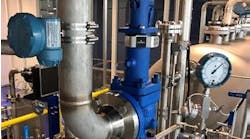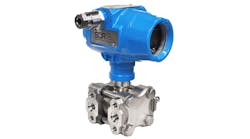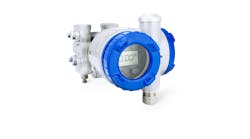Temperamental people are sometimes described as “blowing hot and cold,” and many process applications do the same. Handling and optimizing the changeability of temperature and pressure—if not outright volatility—is one of the cornerstone skills of the process control and automation field. However, along with their rookie counterparts, even longtime experts can appreciate many of today’s improved solutions for smoothing temperature and pressure fluctuations, along with supportive data processing and networking tools that allow wider access to information for better decisions.
“There are more divergent temperature and pressure applications these days, but users still want solid measurements that are easy to work with and don’t cost too much, especially as they add more points, gather more values, and improve communications,” says Keith Riley, national product manager for temperature and pressure at Endress+Hauser. “There’s less resources and expertise to go around, so the goal isn’t so much collecting more or different measurements, but more about making life easier for existing processes.”
Unified cooling control
For instance, South Florida Distillers in Fort Lauderdale, Fla. recently helped 26° Brewing in Pompano Beach, Fla., implement an integrated, cold-side automation system for its 30-barrel brewery, including controls for precise temperature stabilization of seven tanks, expandable to 16 tanks. The controls include AutomationDirect’s Do-more PLC and C-more touchscreen HMI that perform process monitoring, process control, data acquisition and data logging for five conical, 930-gallon, stainless-steel, glycol-jacketed fermentation tanks, which are accompanied downstream by a brite tank for quick cooling and a cold-liquor tank (Figure 1).
[sidebar id =3]
“Though individual PID temperature controllers could have been used for each of the seven tanks, one Do-more controller was a better solution and less expensive,” says Avi Aisenberg, CEO at South Florida Distillers. “The added value of the PLC is its remote viewing, process control and ease of training new users. This design also required less electrical work and will be less costly to expand.”
The temperature of each fermentation tank is controlled by a PID control algorithm running in the PLC, which includes two multipoint AC output modules to control 19 solenoid-actuated water valves. Seven resistance temperature detector (RTD) sensors are connected to PLC input modules to measure tank temperature using clean-in-place RTD probes. For each tank, a PID loop uses its tank’s RTD sensor as the process variable input, and controls three ball valves via the PID controller output. These valves control flow of a glycol/water solution in each tank jacket. Each fermentation tank has three cooling zones, with cooling solution flow controlled by one valve per zone. The brite and cold liquor tanks each have two cooling zones and valves. A ramp/soak pattern can be programmed to last for days or weeks based on the beer being fermented.
The automation system’s HMI has a custom-designed user interface that mimics product process flow. The controller and HMI are networked by an Ethernet switch and wireless access point, which provides network connections for local and remote access to the C-more touchscreen via iPad, iPhone and Android apps running on smartphone or tablet PCs. “This system adds makes interaction with the automation system more user-friendly and easier to setup than with multiple temperature controllers,” adds Aisenberg. “The automation system provides data logging locally at the PLC, and remotely through the Ethernet switch, and a free app lets mobile devices remotely access the HMI. Once remote access is enabled at the HMI and the app is installed, duplicate screens from the HMI can be viewed and controlled remotely from the mobile device. All process data is periodically emailed to predefined users or when there’s a high- or low-temperature alarm, deviation alarm or other condition.”
Tackling extreme settings, safely
Not stopping at simplifying and combining control designs, many temperature and pressure solutions are also acquiring capabilities so they can serve in increasingly remote and harsh settings. To help users test cement used in oil drilling, for example, Fann Instrument Co. in Houston, Tex., has developed a standalone ultrasonic cement analyzer (UCA) to house its pressure and temperature sources, as well as its computer to control its sources and store recorded data. UCAs are used in field labs and drill sites to test cement slurry samples under simulated pressures and temperatures to determine initial sample curing rates. As a subsidiary of Halliburton, Fann’s traditional UCA used autoclaves connected to a common pressure source, while cement curing rate data is read back to a separate central computer. After evaluating several options, Fann selected National Instruments’ CompactDAQ, which integrates connectivity and signal conditioning into a modular I/O device.
“Because of NI CompactDAQ’s modularity, adding functions to our UCA for a custom machine is as simple as plugging in a new module,” says Rick Bradshaw, formerly of Halliburton. “Our new UCA uses an embedded industrial PC, so NI CompactDAQ’s standard USB connectivity eliminated the need for external controllers or interface cards. Also, by using National Instruments’ LabView to create our software, we reduced our development time.
“Now, we can control the temperature, pressure and ramp profiles, and perform other tasks not possible on individual autoclaves. We can also take this standalone UCA into the field, directly to sites, while it would have been difficult to transport the whole system before. We’ve also potentially saved weeks on designing and building new hardware, and gained the flexibility to meet more customer-specific functions by adapting to a wider range of I/O requirements.”
Scott Nelson, VP and GM of Rosemount Pressure Products at Emerson Process Management, reports, “As our customers push the limits of their operations, we’re being asked for more solutions that can withstand extreme environments and severe chemical conditions. As a result, six months ago, we introduced our Rosemount 3051S High Static DP pressure transmitter that can accurately measure differential pressure from 5 in.H2O to 150 psi on top of 15,000 psi line pressure. It’s available with wired or wireless communications, and measures differential pressure (dP) and process temperature all in one.”
To enhance personnel safety in these challenging applications, Nelson adds that Emerson also recently introduced its Rosemount Wireless Pressure Gauge (WPG). Unlike traditional pressure gauges that include a mechanical Bordon tube, WPG is based on Rosemount sensor technology that can handle 11,000-psi burst pressure, provide self-monitoring diagnostics and expand insight with WirelessHART. “We weren’t in the pressure gauge industry before, but it’s a need for our customers, so we’re bringing our pressure transmitter technology into pressure gauge applications.”
Better tools + networks = better data
Likewise, to enhance the safety of its boiler control system by generating remote updates, McKee Foods Corp. in Collegedale, Tenn., has implemented eWon’s 2001 PSTN router and 4001 GSM/GPRS modem to notify maintenance personnel of current alarm conditions and let them shut down the boiler remotely, using land lines or cellular phones. This solution allowed the baker of Little Debbie snack cakes and other bakery products to comply with state regulations requiring any boiler systems to be monitored during operation by plant personnel, but now they no longer have to be onsite 24/7.
Consequently, the eWon rounter and modem communicate with the bakery’s Allen-Bradley CompactLogix controller via EtherNet/IP networking to monitor alarms, including loss of communications, high-steam pressure and others. Connections between McKee’s control system and its operators are enabled by eWon’s Talk2M server, which creates a network tunnel and secure virtual private network (VPN) between sender and receiver.
[javascriptSnippet]
When a critical alarm is detected, an SMS text message is sent to a preset list of cellphones and pagers, allowing operators to respond to the eWon units via cellphone or landline, and shut down the malfunctioning boiler. Staff can then go to the boiler, and begin diagnostics using eWon’s data, including alarm history, events and historical datalogs to determine the failure source.
Similarly, because temperature readings are critical to the life sciences and their instruments need frequent calibration, Riley adds Endress+Hauser recently launched its iTherm QuickNeck thermometer extension neck with 1/4-turn quick release and IP69K protection. “Even aided by mobile devices, transmitters have to be unwired, opened, checked and wired, which takes about 30 minutes,” says Riley. “QuickNeck’s 1/4-turn gets the transmitter head and probe out of the thermowell and back in 10-15 minutes, which saves time and reduces the chance of an alarm, and lets the RTD continue measuring. Also, while a regular RTD can only handle 3-4-G vibrations, we have a new thin-film RTD that can withstand 60-G vibrations, so it doesn’t need to be replaced as often.” Thin-film RTDs also can provide 2-3-second response times, which are comparable to a thermocouple, rather than the traditional RTD response time of 12-15 seconds.
Unlike its foray into mechanically aided safety with the WPG, Emerson’s Nelson explains that many temperature and pressure components are becoming more electronic and less mechanical because they’re more efficient, cost effective, and save time for users. For example, he says Emerson’s new Rosemount 3051S Electronic Remote Sensors (ERS) system eliminates mechanical impulse lines and the troubleshooting and maintenance they often require. Users also appreciate that ERS only takes one person less than two hours to install, while traditional mechanical devices can take two people six to eight hours to install.
“Previously, dP transmitters were connected to tanks with a mechanical system, which allowed outside ambient environmental changes to create instrument error,” says Nelson. “Now, we put two pressure sensors on a tank that are connected electronically, which eliminates prior sources of errors and maintenance, and are five to 10 times more accurate.”
[sidebar id =2]




